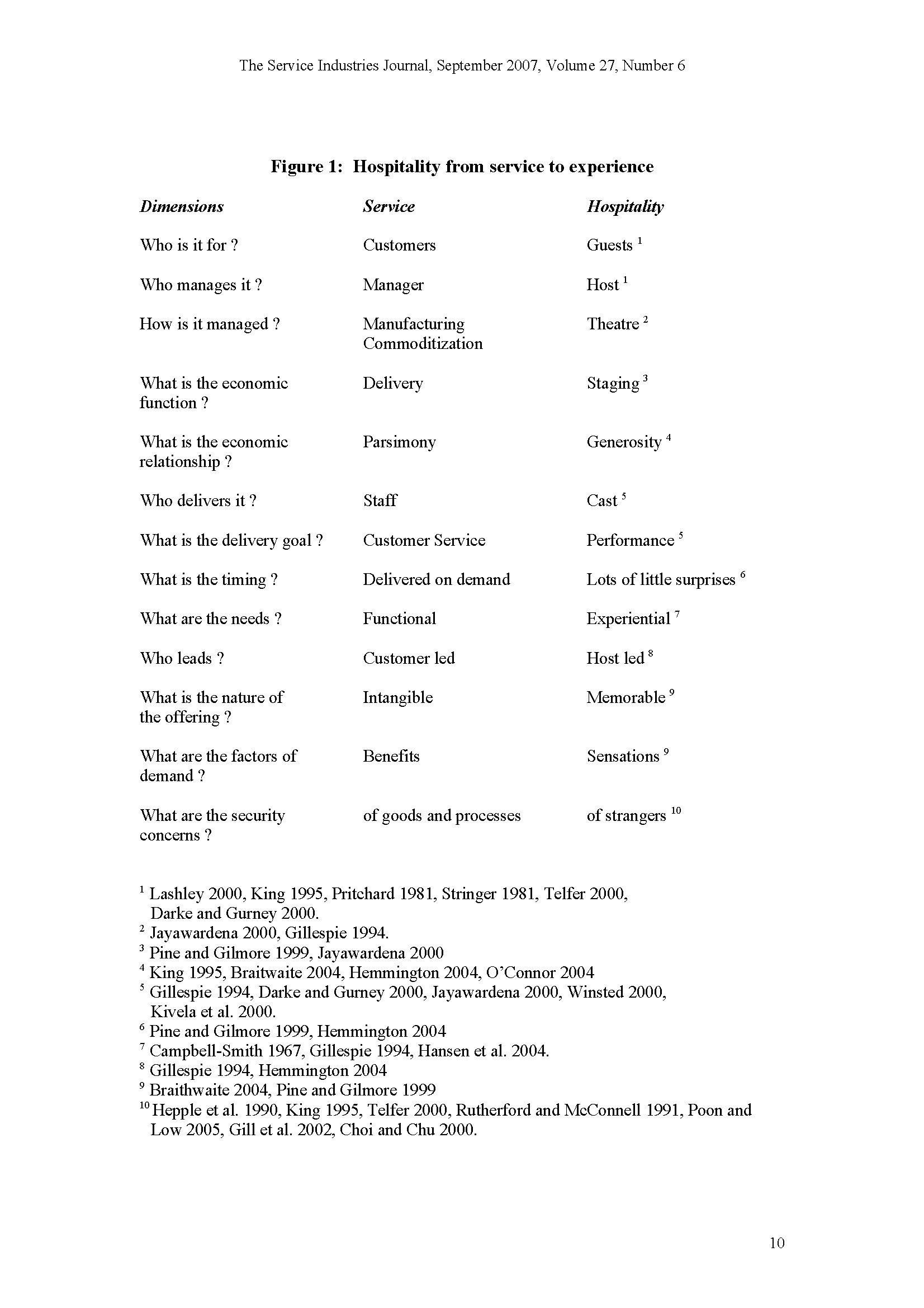Research: From service to experience: Understanding and defining the hospitality business

Paper (2007) by: Nigel Hemmington. Source: https://doi.org/10.1080/02642060701453221.
I have read the paper so you don't have to. The 5 biggest lessons that teach you about the essence of hospitality, tourism and leisure management.
Hospitality management as a field of study “continues to struggle for definition”. This failure to understand the phenomenon of commercial hospitality acts a significant barrier to industry improvement (Wood 1992), customer satisfaction and therefore growth.
Slattery (2002) is clear in his view that;
‘Hotels, restaurants, bars and the other hospitality venues are businesses where the critical relationship is between sellers and buyers. The buyers are not guests, they are customers. The relationship is not philanthropic it is economic.’
[The current approach] is dominated by the perspectives of supply and suppliers, it is not one that customers recognise, it is not the language that customers use, and it is not an approach that reflects the consumer experience or demand perspective (Nailon 1982). The retention of a customer perspective is essential to the effective delivery of hospitality products; customers do not buy service delivery, they buy experiences; they do not buy service quality, they buy memories; they do not buy food and drink, they buy meal experiences.
In seeking a better definition and understanding of hospitality a more fruitful starting place might be a consideration of the nature of hospitableness; hospitality as behaviour and experience (O’Connor 2005).
Lashley (2000) states that, 'hospitality is essentially a relationship based on hosts and guests' and it is the host-guest relationship that is the key distinguishing characteristic of hospitality from which several other dimensions emerge (Pritchard 1981, Stringer 1981). The notion of hosts and guests is fundamentally different to that of managers and customers and is much more socially and culturally defined.
In order to explore the conceptual shift from service and services management to hospitality and experience management it is helpful to distinguish a number of key dimensions that characterise the differences between the perspectives.

In experiences, such as hospitality, this concept is extended by the fact that the performance and experience is revealed over time (Pine and Gilmore 1999). This has interesting operational implications. The hospitality experience could take place over a couple of hours for a meal, days for a short hotel visit and weeks for an extended vacation. In all of these, however, it should be recognised that the experience is not delivered in one moment in time, but is revealed over time, and over an extended period of time in some cases.
[There are] a number of interesting tensions between hospitableness and commercial hospitality. The most obvious being the tension between generosity and the economics of business.
The need to control costs and generate a financial return is the economic reality of hospitality business, but is not one that normally applies to hospitality in social environments. This leads to several tensions when businesses attempt to provide a true sense of hospitality, for example, requiring guests constantly to sign for products acts as an on-going reminder of the economic relationship (O’Connor 2004), charging for minor elements of the product (e.g. butter, sauces) that could be included as part of the whole.
Accepting that businesses have to make a financial return, the challenge would seem to be one of distancing the guest experience from necessary internal financial controls, and removing or redesigning unnecessary controls.
A good example of this is the “all-inclusive” format where the financial aspect of the relationship is dealt with once, and usually before the experience. This then enables the hospitality experience to develop without reminders of the economic relationship and for a sense or generosity to be developed.
The focus on experience and performance suggests an interesting analogy with theatre. In both hospitality and theatre there is a need to stage-manage experiences and a sense of staging the environment.
[Yet] most hospitality experiences are individual and personalised rather than batch delivery as they are for a theatre audience.
The notion of performance is significant both in terms of the guest experience and the implications for staff as performers (Darke and Gurney 2000). If performance is an important aspect of the experience, which Winsted’s (2000) research indicates it is, organizations should explore the opportunities to enhance the levels of performance.
Staff, as the cast who provide the performance, need to be selected and developed as performers and need to be provided with the opportunities to perform.
It is interesting to note that in recent years most of the performance in restaurants has been withdrawn into the kitchen with the chefs leaving the restaurant staff with limited opportunities to perform.
In services, much play is made of the fact that services have to be delivered on demand and that the product and customer have to be brought together at critical moments in time.
Another key dimension of hospitality [is the] extent to which the experience should be customer led or host led. Market orientation dictates that consumer products should be consumer led and that organizations should respond to the needs of the customer. However, if the intention is to create guest surprise, the creative ideas for the surprise are unlikely to come from the guests themselves.
This means that the innovations are more likely to be host led and will depend upon the creativity of the host and the staff as performers. It means that they have to interpret the needs of their guests in unusual and exciting ways that create memorable experiences.
Telfer (2000) points out that “traditionally the most important responsibility of all was the guest’s safety - hospitality was a kind of sanctuary”. In most service industries, however, the dominant security concerns relate to the security of goods and procedures, this is also the case in some hospitality organizations, this leads to a focus on control procedures and financial control issues dominating the hospitality experience. [...] Security in hospitality should, therefore, focus on guest security – the security of strangers.



